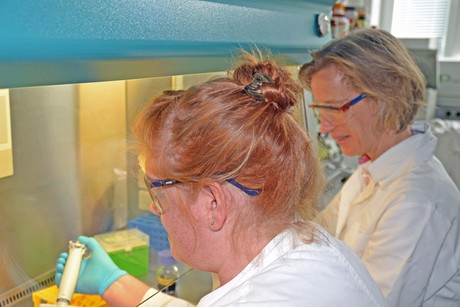Stopping biofilms before they start

Slimy biofilms are a perfect environment for microorganisms — here, protected against external influences, bacteria can grow undisturbed. They can be the food processor’s scourge as eliminating biofilms can be quite difficult. Much better to stop them forming in the first place. This is what researchers at Kiel University, in cooperation with colleagues at the Hamburg University of Technology, are trying to do.
Their study shows that strategies from nature are particularly effective at inhibiting biofilms. Biofilms originate when cells attach to surfaces and organise themselves into coordinated three-dimensional consortia, embedded in an extracellular matrix. This matrix can protect pathogenic bacteria from sanitisers allowing them to proliferate and reinfect equipment and product.
In order to coordinate themselves and establish consortia on surfaces, the bacteria must communicate with each other via signal molecules (autoinducers). If this communication is disrupted, no biofilm can be formed. This cell-to-cell communication, known as ‘quorum sensing’ (QS), can be influenced by disruptive biomolecules (‘quorum quenching’ or QQ proteins). Proteins can break down these signal molecules, or modify them in such a way that they are no longer functional.
The Federal Ministry of Education and Research (BMBF) in Germany is funding the research to find QQ proteins which disrupt this communication between bacteria as effectively as possible. In contrast with previous studies, Professor Ruth Schmitz-Streit and Dr Nancy Weiland-Bräuer, also from Kiel University, concentrated their search on natural environments outside the laboratory.
“Because principles which occur in nature have evolved and established over a long time period and are therefore particularly effective,” said Schmitz-Streit.
This was demonstrated by the research team by means of a metagenomic approach: they took samples from seawater, from glaciers, but also from jellyfish or from biofilm residue from a washing machine. They extracted the complete DNA from the samples and used this as a basis to identify proteins with the ability to break down the signal molecules, or render them ineffective.
While doing so, Schmitz-Streit and Weiland-Bräuer determined that the number of QQ proteins which can prevent cell-to-cell communication is extremely high in the marine environmental samples taken — higher than with terrestrial samples. “As the oldest ecosystem, the marine system — including the oceans, water or algae — is incredibly rich in new, undiscovered substances. It offers a huge potential regarding biological activities and QQ mechanisms,” said Schmitz-Streit.

The research group discovered even more: the communication-disrupting protein QQ-2 proved itself to be particularly effective during the investigations. “This protein is very robust and can prevent many different types of biofilms,” explained Weiland-Bräuer. Previous studies focused more on disrupting a particular language of bacteria. “In contrast, the QQ-2 protein is orientated towards a ‘universal language’ and can disrupt the communication of different bacteria. This makes it a ‘general troublemaker’.”
This fundamental research provides important results which may lead to biotechnological and medical applications in future. If the communication of pathogenic bacteria can be deliberately disrupted, bacteria will be prevented from forming biofilms.
The biologists have published their findings in Frontiers in Microbiology.
Six beverage trends predicted for 2026
Demand for customisation, 'protein-ification' and sustainable storytelling are some of...
Making UHT processing less intensive on energy
A nutritional beverages company was seeking a more sustainable way to produce UHT beverages using...
Tasty twist for chocolate alternatives
Food scientists develop two novel flavour-boosting techniques to transform carob pulp into a...








